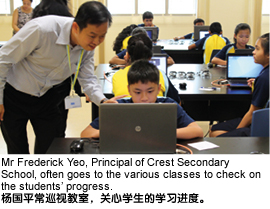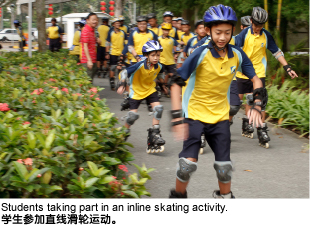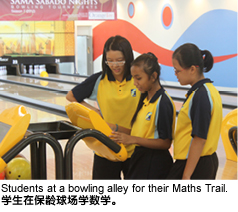
Normal (Technical) (N(T)) students — those who are academically weaker but work better with their hands — form about 13 per cent of each cohort. In recent years the Ministry of Education (MOE) has been steadily enhancing the N(T) course to ensure that all students are catered to and no child is left behind. In line with this objective, the MOE announced in October 2011 that it will adopt a whole school experiential learning approach in setting up two brand-new specialised institutions for N(T) students — Crest Secondary School, which started this year, and Spectra Secondary School, which will open in 2014.
A year after it opened its doors, the report card for Singapore’s first specialised school for N(T) students is a glowing one: the 200 N(T) students who enrolled at Crest Secondary School in January this year are responding well to the curriculum, and the School is clocking up a 97 per cent attendance rate. This is no mean feat considering that these students might previously have been indifferent about going to school at all.
Mr Frederick Yeo, Principal of Crest Secondary, says that the School’s success is due to two key factors: how the School delivers its curriculum, and its nurturing culture.
Integrating Academic Learning and Vocational Training
 Crest Secondary offers an N level academic curriculum and a four-track vocational curriculum in Facility Services, Mechanical Servicing, Hospitality Services and Retail Services. At Secondary 1 and Secondary 2, students do “taster” modules in all four vocational tracks which will expose them to the knowledge and skills related to each vocational area. At Secondary 3 and Secondary 4, they will specialise in their preferred vocational training track. They will graduate with not only an N level certificate, but also an ITE Skills Certificate. Crest Secondary offers an N level academic curriculum and a four-track vocational curriculum in Facility Services, Mechanical Servicing, Hospitality Services and Retail Services. At Secondary 1 and Secondary 2, students do “taster” modules in all four vocational tracks which will expose them to the knowledge and skills related to each vocational area. At Secondary 3 and Secondary 4, they will specialise in their preferred vocational training track. They will graduate with not only an N level certificate, but also an ITE Skills Certificate.
The School adopts a customised “spiral” curriculum that is geared to the students’ pace of learning and builds on their competencies as they progress from one stage to the next. Pedagogies also play to students’ interests to engage them meaningfully. For example, as students these days are very familiar with social media, blogs are used as a teaching tool.
Elaborating on Crest Secondary’s curriculum, Mr Yeo said, “We have two branding positions: the first is that the School provides a secondary education for N(T) students in non-traditional ways that appeal to students’ interests, and the second is that the curriculum integrates both academic learning and vocational training.
“We do this so that students who may not be academically-inclined can pick up book knowledge in a practical manner. Once they are given the chance to do what they’re interested in, they display a high level of curiosity and motivation.
“For example, the English department took the students out to the neighbourhood shops and they learnt to use adjectives to describe scenes in sentences like, ‘This is a very untidy store’, and ‘This is a vibrant and busy market’. When it comes to vocational training, students learn to fix bicycles, do food preparation and wait on tables. Relevant knowledge and skills from the academic subjects are integrated into the vocational training process, and vice versa, where appropriate,” Mr Yeo said.
The School boasts purpose-built facilities including a Home-Fix store, a Giant supermarket and a hotel training room supported by the Ritz-Carlton, Millenia Singapore hotel. Students can attend lessons and learn English and Maths respectively, as they serve customers, and restock and arrange products on the shelves in Giant.
Nurturing School Culture
Unlike in a mainstream school, Crest Secondary’s culture has to go beyond fostering a love for learning. As these students may have low self-esteem or lack confidence, Crest Secondary focuses on instilling a sense of optimism about schooling by creating a nourishing school culture. With a diverse school population, students also get to interact with peers who have different interests, talents and perspectives, which makes school interesting for them too, even though they are all from the same stream.
“We have an open and affirming culture,” said Mr Yeo. “During assembly, we have a dialogue session between the discipline master and two or three students. The students have a chance to talk about what’s gone on in school and why they like to come to school. This happens at least once a week and everybody listens.”
Creating a positive school culture means that the students will leave the School with a sense of confidence about their future. Mr Yeo told us that when the students started school, many of them lacked self-belief and didn’t even want to make eye contact during conversations.
“We told them that making eye contact when conversing is a sign of respect as well as an indication of their confidence level. After a month or so, they began to open up and now they are all very happy. Students thrive at Crest Secondary because they sense that they are all the same, and are given equal opportunities. There is no favouritism in the School,” Mr Yeo said.
Preparing them for life also means that they learn life skills, and Mr Yeo asks his teachers to help students with things like managing their emotions and recognising their obligations to be punctual, to keep promises and to take pride in their work.
If students do well enough academically, they will be given a chance to do English and Maths at the Normal (Academic) level, and for those who have the opportunity and desire to, they can even transfer to a mainstream school which offers the Normal (Academic) course.
They are also given opportunities to exercise leadership.
“When it comes to co-curricular activities (CCA), there are ample opportunities for students to take up leadership positions, and everyone has an equal opportunity to be a leader. When students do something right, we will affirm them. Of course we catch students doing wrong things but we don’t harp on these. We celebrate and affirm the good things a lot more often. At the end of the day, we want a positive culture. Every Crestan matters and our teachers must believe in that,” Mr Yeo added.
Building Confidence by Connecting with Others
 Mr Yeo also seeks to inspire the students by letting them engage with pupils from other schools in the pursuit of various activities. Mr Yeo also seeks to inspire the students by letting them engage with pupils from other schools in the pursuit of various activities.
These partner schools include Commonwealth Secondary School for Girl Guides, Raffles Institution for Scouts and ACS (Independent) for the band. Plans are also in the pipeline to tap on other schools for student leadership opportunities.
“At the end of the day, what draws everyone together is the sense of social camaraderie where students can connect with others of different backgrounds. If we share empathy, this world will be a better place.
“The partnerships are good because we want leaders who are compassionate, and who can empathise with the needs of less advantaged students, and the respective schools only send students who are ready and patient. These partnerships have been very positive so far, and it is important for our students to know that there is competition in life. Just because they are the top in Crest Secondary doesn’t mean they would be top in every school. There will always be people who are stronger, whether it be in discipline, skills, intellectual ability, or sports and games,” Mr Yeo said.
Another institution that Crest Secondary is exploring partnership opportunities with is Yale-NUS College and Mr Yeo is particularly interested to see how undergraduates studying liberal arts degrees will build relationships with their much younger juniors from an N(T) background.
Extraordinary Teachers
Teachers at Crest Secondary clearly have to go beyond just imparting knowledge in class.
According to Mr Yeo, they must first believe in the students before they can reach out to them. They also need to be able to identify their students’ learning needs, and be both dedicated and patient so as to make a personal impact on the students’ lives. Teachers have to be mindful not to categorise students or compare them with their peers from mainstream schools, but instead see them for who they are and for the potential they possess.
As a tangible reminder of their situation, Mr Yeo and his team of teachers have come up with five fundamental beliefs: every Crestan matters, every Crestan can learn, every Crestan has unique strengths and talents, every Crestan can succeed, and every Crestan can make a difference in the community.
“There’s a need for us at the school level to be encouraging because very often the children battle psychological and cognitive issues. Of course our children will have academic limitations — that is why they’re in N(T). But we believe that they matter and they have unique strengths and talents too. To teach at this school, a teacher who comes here must be willing to give generously of himself or herself.”
To equip teachers with the appropriate skills, a professional development programme is conducted fortnightly. It covers curriculum development for both academic subjects and vocational training courses, as well as pedagogy. It equips the teachers with the skills to incorporate effective teaching tools by using information communication technology to make lessons more visually attractive, appealing and hands-on. Teachers also learn how to design tasks or test questions that are meaningful, authentic, hands-on and skills-based. Another important aspect which they are trained in is understanding the special learning needs of students with dyslexia and attention deficit hyperactive disorder (ADHD).
They also go the extra mile to work with their students’ parents.
Engaging Parents
 At Crest Secondary, the school management and teachers do not just look at how students perform in school. As some of the students come from disadvantaged or troubled backgrounds which may have compromised their school careers, it also actively engages the parents, who play a crucial role in their child’s development. At Crest Secondary, the school management and teachers do not just look at how students perform in school. As some of the students come from disadvantaged or troubled backgrounds which may have compromised their school careers, it also actively engages the parents, who play a crucial role in their child’s development.
At the beginning of the school year, teachers visited the homes of students to get to know them and their families better. Starting with those who came from disadvantaged families or who had learning difficulties, the teachers went with gifts as gestures of goodwill.
“The home visits opened our eyes to the kinds of very challenging environments that some of our children live in, and this has helped us to be more understanding,” said Mr Yeo. “For example, we have a student who lives in a one-room flat together with more than ten other people. There is obviously no proper place to study, so the student has to go down to the void deck or somewhere else, or not study at all, because the place is just not conducive. It is thus important that we have proper studying facilities in school.”
In response to the gaps they observed during these home visits, the School has created a better learning environment. An example of this is the student recreation hub, where students can go to study or take part in recreational activities when school ends.
To further engage parents, two outreach sessions have been organised — the first in January and the second in May, in conjunction with its street soccer and cupcake making competitions. In addition to these outreach sessions, there is also a meet-the-parents session at the end of every term.
In November, the School will be conducting parenting workshops in English, Chinese, Malay, and Tamil to reach as many parents as possible.
“Having workshops conducted in the four languages is a way to assure parents that even though they are not English-educated, it is perfectly alright. We don’t want them to feel left out, which a lot of parents sometimes feel. The parents may not be aware of what is happening in school, because when they were children themselves, they didn’t have a positive schooling experience, partly because their own parents might not have cared about them. We want to break the vicious cycle for their children in our School now. Many of our students are from financially needy backgrounds and half of them are on financial assistance. There is a need for us to do extra for them,” Mr Yeo elaborated.
Looking to the Future
Mr Yeo is currently busy with raising awareness of the School and the good work it has been doing.
In order to do this, he has two strategies — to arrange for potential students to visit the School and to hold an Open House. In line with the first of these, students at 11 primary schools who were enrolled in the Primary 6 Foundation class — which is a less rigorous curriculum — visited Crest Secondary in October for an immersion programme, which gave them a chance to experience the school curriculum, look at the facilities and interact with current students.
The 2013 Open House will be held on 23 and 24 November to coincide with the release of the Primary School Leaving Examination (PSLE) results.
“Last year, it was a challenge to introduce our School to parents because when they visited us during Open House, the whole place was covered in scaffolding as the School was still undergoing construction. A very important thing we therefore did was to position the School based on its mission of using skills-based, practice-oriented learning experiences to help students who may find it challenging to manage an academically driven curriculum in mainstream schools. Another important thing we did was to have talks for parents in all four languages, which we will continue doing this year.”
Ultimately, Mr Yeo wants Crest Secondary to become a lead school for the N(T) stream and to be in a position to share its best practices with other N(T) schools in two or three years’ time. “The MOE has invested so much in a school specially for N(T) students, so it is our responsibility to the community to share some of the practices that have worked for us.”
|